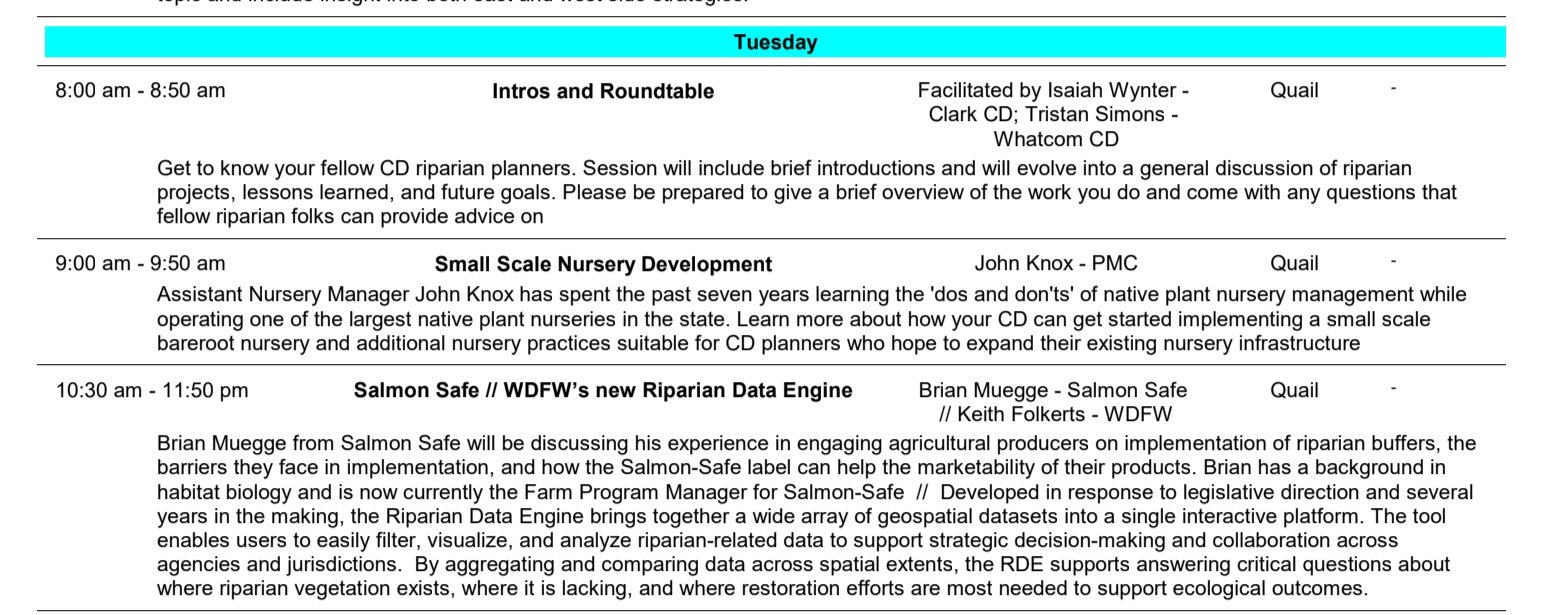Presentation at WA Association of District Employees
Last week on June 10, I went to Leavenworth to present about small-scale nursery development at the Washington Association of District Employees conference. I drove over the mountains and back in the same day. The event was held at the Sleeping Lady. The weather was sunny and hot. The grounds smelled sweet and piney, and there was a bear hanging around the pool the night before I got there. Gladly, me presentation was in the morning, so I could have time to engage with people before I headed home. There were around 30 people in the crowd, and they were engaged and curious. It was a good day to spend with peers and colleagues, and it is always refreshing to get with a big crew who share values and effort in a do-it-together type of work.
Thank you to Isaiah Wynter and Tristan Simons who believed that I had something valuable to contribute to the event and especially thank you for honoring my request by not putting me after lunch.
I talked for about an hour with frequent breaks for questions and answers and comments and some good laughs. I spoke to some of the considerations to have before starting a nursery. Secure your land a water access, mock up a business plan, and have a plan to deal with pests. It’s a hungry world, and we all have to eat. After that, I presented on the state of the gravelbed project. It has grown from one to seven sites over a few years, and there are nearly 50,000 plants that have gone through it. I talked about how it allows for bareroot plants to be available for fall plantings, the cost savings that comes with these plants, and how you don’t need a cooler to store them. Each benefit is found like opening up a set of Matryoshka nesting dolls.
Really!?
You can have bareroot plants in the fall.
What!?
They’re cheaper than potted plants.
No way.
You can make the beds out of scrap materials.
Sweet.
You can use hand tools to maintain it.
Pollution sucks.
And you don’t even have to dig into the land to have them.
I’m sold.
You don’t even have to dig into the ground to grow plants. How cool is that?
Super cool.
Anyway, that is one part of the small-scale nursery, and the newest addition is the air-pruned bed.
An air-pruned bed is a way to grow a bunch of plants in a small space. It is a raised, raised garden bed, and the column of air between the bottom of the bed and the top of the surface is its defining characteristic. The plants’ taproots sense the air column, and they self-prune triggering the plant to grow more lateral branches. This bed cultivates plants to increase the root area where the most water and nutrients are available to the plant, and it makes them easier to harvest out the bed in the winter. I like that I can adjust the depth of the soil to manipulate the size of the plants that I want. This way, I have more flexibility if I want to pot up small trees, sell them as liner stock, or transplant them into the gravel bed. I love versatility and flexibility, and growing a ton of plants in a small spot.
I imagine that these two beds will work together, and I can proselytize about this nursery configuration, and get more plants in the spots where they are needed the most.
The groundwork is laid for the fruitful growth of these nurseries. There are seven sites at conservation districts throughout Western Washington, and they will get experience working with the gravel beds. I want an information sharing channel to share lessons learned and showcase the good that people do with them. And then I want, these productive nurseries to be demonstration sites for growers, educators, workers, and other partners to interact with to make a much greener world.

